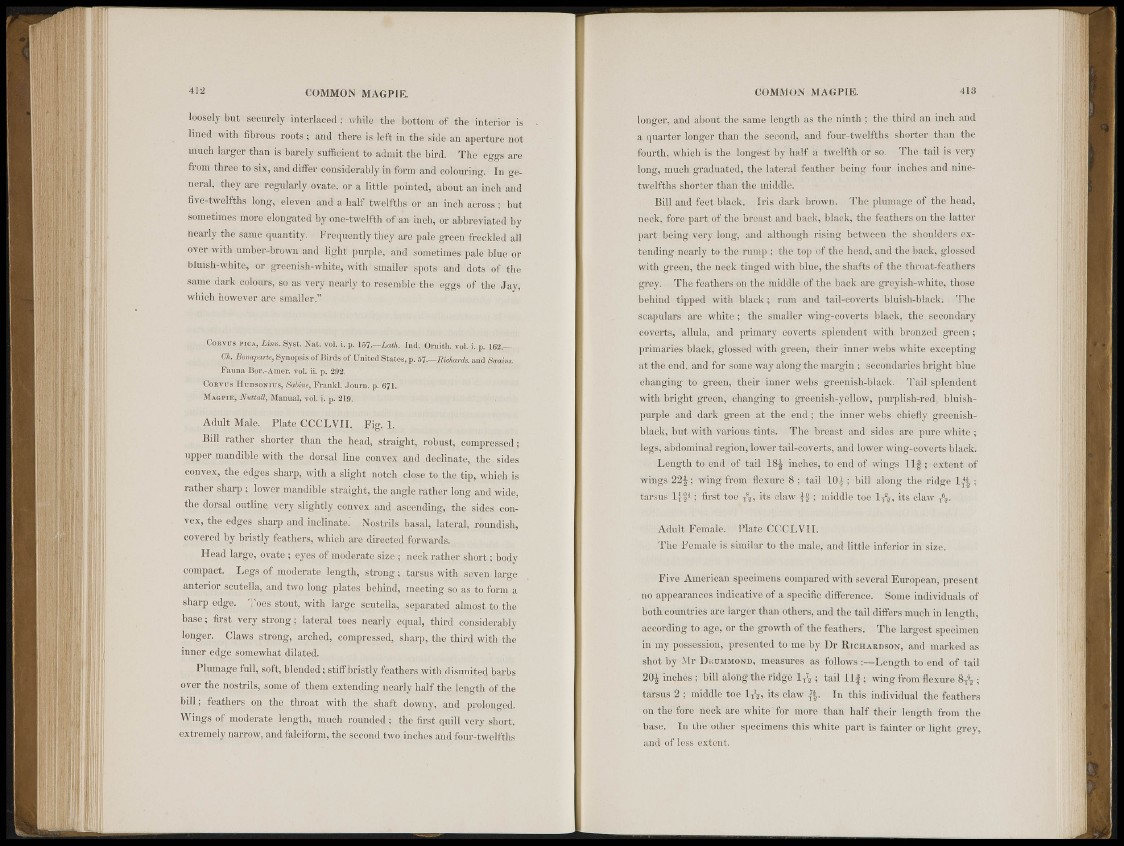
413 COMMON MAGPIE.
iSSèlJî liul securely interlaced :'.while the. bottom of the interior -is
lined with,: fibrous routs ; and there' is,left in the side an aporture not
m , " ' h 1*1® til''» is barely sufficient to admit the bird. Tie eggs are
from three to six, and differ considerably in Ibrm and colouring. In gt t
•"o r a l ' tbey-are regularly ovate. or a licilts pointed, about ail inch and
five twelfths long, eleven and a half twelfths or- an inch across.;, but
sometimes more elongated by one.-twelfth of an inch, or abbreviated by
nearly the snnti 'quantity. Frequently they p « pale green. freckled all
<,vt'r W ® utnbfir-brown and light purple, and Sometimes pale blue or
bluish-white, 'or -greenish-white, with smaller ¡spots and dots of tlie
same dark colours, so as very nearly to resemble the eggs of the .lay,
which however are smaller."
CJoltvus mca, £ iw.%s t . Nat. vol', i. ,p. 1 57.—£iitf<; Ind. Omitli., vol. i. p. 162.^.
Fauna Bor.-Amer. volTTi'"p'. 292
(.'«¿vis' IhnisoNirs, -SV/i/ic, Frankl. J num. p. 671.
Ma(;?!K, .VmîîVî, Mamutl, vol. i. p. 219.
Adult Male,. Plate. CXCLVII. {Sg 1.
Bill rathqr shorter than thé h.;a<|, straight, robust, compressed ;
upper mandible with the dorsal line convex and^cLlinato, the sides
convex, the eâges sharp, with a slight notch close.to the tip, which is
rather sharp ; lowermandible straight, the angle ratiher long and wide,
the dorsal outline very slightly convex and ascending, the sides, convex,.
the edges sharp and inclina^: Nostrils basal:, lateral, roundisij,
covered bv bristly feathers, w hiçh ai'c directed forward».
Head large, ovate,;.eyes;- moderate«®; neek rather, short : body
compact. Logs of modorateT.Icmai:h, strong ; tarsus with seven large
anterior senfelja, and two long plates behind, meeting so as to form a
sharp edge. Toes stout, with largo scutella, separated almost to the
base; first very strong;., lateral toes nearly equal, third eonsideralily
longer. ^ Claws strong, arched, compressed. sharp, the third with the'1
inner edge somewhat dilated.
Plumage full, soft, blended ; stiff bristly feathers with disunited barbs
over the nostrils, soine of them extending «early half the length of the
bill; feathers on the throat with jjio shaft downy, and prolonged.
Wings of moderate length, much rounded ; thé flfflt quill very short,
extremely narrow, and falciform, the second two inches and lour twelfths
COMMON MAGPIE. 413
longer, and about the same length as the ninth ; the third an inch and
a quarter longer than -the second, and, four twelfths shorter than the
fourth, which is the longest by half a twelfth or so;. The tail is very
long, much graduated, the lateral feather being four inches and ninet
wolfths shorter than the middle.
Hill autl ¡'cut black. Iris dark brown. The plumage of the head,
neck, fore part of the breast and back, black, the feathers on the latter
part being very long, and although rising between the shoulders extending
nearly. tit tho'rump : the top of the head, and the'back, glossed
w ith green, the neck tinged with blue, the shafts of the throat-feathers
grey. Tile feathers oti the middle of the back are greyish-white, those
behind tipped "with black ; rum and tail coverts bluish-black; The
scapulars are white : the. smaller wing-coverts black, the secondary
coverts, allula, and primary coverts splendent with bronzed green ;
primaries black, glossed with green, their inner webs white excepting
at the end, and for some way along tin: margin ; secondaries bright blue
changing to- green, their inner wëfei greenish-black. Tail splendent
with bright green, changing to greeni.sli-yt-¡low. purplish-red, bluishpurple
and dark green at the end : the inner webs chiefly greenishblack,
-but -with various tints. The breast and sides are pure white;
logs, abdominal region, lower tail-coverts, a-nd lower wing-coverts black.
.. Length to end of tail 18| inches, to end of wings 11$ ; extent of
wings 22 s ; wing iroin llexure 8 ; tail 10| ; bill along the ridge l i t ;
tarsus 111* ; first toe its claw ; middle toe l tv, its claw TV
Adult Female. Plate (XC1.VU.
. The Female is similar to the male, and little inferior in size.
Five American specimens compared with several European, present
no appearaneBS indicative of a speciSç difference. Some individuals of
both countries are larger than others, and the tail differs much in length,
according to age, or the growth of the feathers. The largest specimen
in my possession, presented to me by Dr Richardson, and marked as
shot by Mr Dkummond, measures, as follows :—Length to end of tail
20J inches ; bill along the ridge 1 | | ; tail l l f ; wing from flexure 8 ;
tarsus 2 ; middle toe" l-Js,. its claw In this individual the feathers
ên the fore nock are white'for more than half their length from the
base. In the other specimens this white part is fainter or light grey,
and of loss extern.